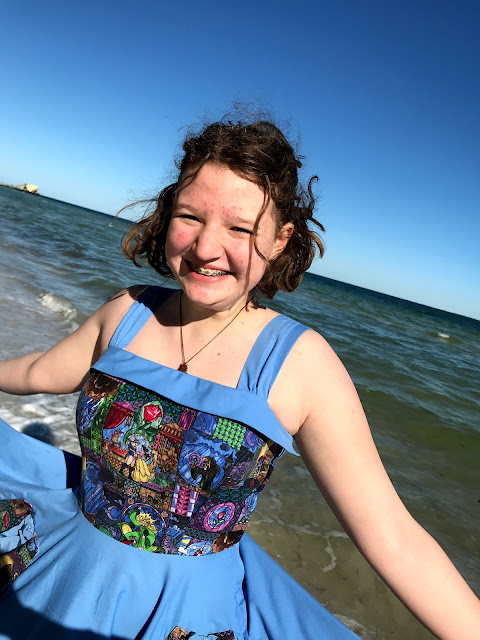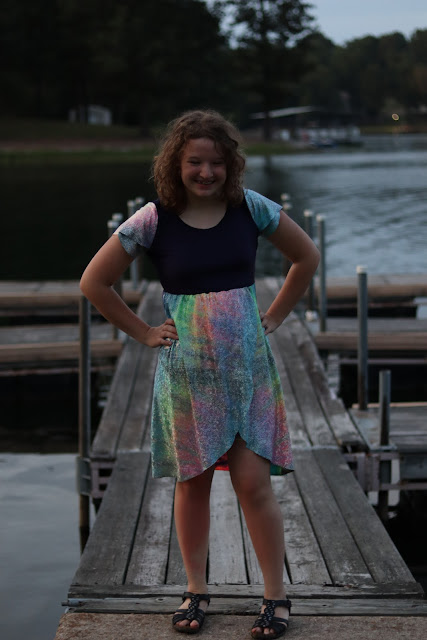I had a couple different ideas for this challenge, but you know what's really limited in December? Time. With all the Christmas sewing I had to do, I ran out of time to do the elaborate (but inexpensive!) project I had planned. Thus, on the 30th of December, I realized if I was going to actually finish a project for the challenge of the month, I needed to pick a much simpler project to complete in the next 24 hours. Thankfully, I did have such a project on hand. One which cost very little and should only take a couple hours to make, start to finish - a faux-quilted 18th century petticoat.
Back in October I found half of a cotton matelasse bedspread at a thrift store for about $2.
Now I didn't know the history of matelasse cloth at the time, but I did know I'd seen other historical costumers use it to make 18th century petticoats, so I snapped up that half of a bed spread just as fast as I could. Why was it just half a bed spread, not a full one? I have no idea, but I'm thankful the thrift store decided to sell it anyway, rather than trashing it or something.
When I finally got around to turning this bed spread into a petticoat at the end of December, I cut it into 2 panels measuring about 50" wide and 1" shorter than my shortest 18th century outer petticoat. This would give me a finished petticoat with a 100" circumference (100" appears to be a standard circumference for a quilted petticoat according to my research) which I would be able to wear beneath my other 18th century petticoats without it peaking out at the bottom.
Panels cut, the petticoat was then completely assemble by machine. Side seams sewn, seam allowances zig-zagged, pocket slits hemmed, top edge pleated and bound in twill tape.
There was no need for a bottom hem, as I decided to use the lovely scalloped edge from the bed spread as the bottom of my petticoat, so it was already finished.
I put the petticoat on with my stays, shift, and cap, then dragged my little brother outside to take pictures of me.
We did a little photo sequence showing how the petticoat is put on.
Front of the petticoat pulled up.
Then tied in the back.
Petticoat securely on!
Pictures taken, I hurried up and posted my finished project in the Historical Sew Monthly Facebook group - and received a nice surprise when I was informed my material choice was a heck of a lot more historically accurate than I'd thought it was.
I'd figured cotton metalasse was a relativity modern fabric, probably not around in the 18th century, just used by costumers now because it resembles quilting from the 18th century, without requiring hours upon hours of hand quilting (something I currently have no desire to do.) Well, I was wrong. (And doing my fellow historical costumers a huge disservice in my thinking.)
It turns out matelasse was developed in England in the early 18th century to replicate the hand quilting done in France - so this stuff was actually invented for people to make fake quilted petticoats from! Just more than 100 years earlier than I thought it was! (You can read a bit more about this fascinating fabric here)
The Challenge: On a Shoestring
What it is: A faux quilted petticoat.
Material: Cotton matelasse. It came to me as half a bed covering from a thrift store. It’s a thick cotton (according to a burn test) with lots of body and a woven in floral pattern which resembles quilting.
Pattern: None, just two rectangles pleated onto waist ties.
Year: 18th century
Notions: Cotton twill tape and thread
How historically accurate is it? It’s entirely machine sewn, but the material is plausible, the “pattern” is accurate and I believe it would be recognizable in the era. Also, there are a couple 18th century garments at LACMA which appear to be made from re-purposed bed covers, which is what I did here. I’d give it a 50%-60%.
Hours to complete: Less than 2.
First worn: Just for pictures 12/30/19
Total cost: The coverlet was $2 at a thrift store. The twill tape was $1 a yard and I used about 2.5 yards, so that $2.50. Add 50 cents for the thread used for a total of $5.
What it is: A faux quilted petticoat.
Material: Cotton matelasse. It came to me as half a bed covering from a thrift store. It’s a thick cotton (according to a burn test) with lots of body and a woven in floral pattern which resembles quilting.
Pattern: None, just two rectangles pleated onto waist ties.
Year: 18th century
Notions: Cotton twill tape and thread
How historically accurate is it? It’s entirely machine sewn, but the material is plausible, the “pattern” is accurate and I believe it would be recognizable in the era. Also, there are a couple 18th century garments at LACMA which appear to be made from re-purposed bed covers, which is what I did here. I’d give it a 50%-60%.
Hours to complete: Less than 2.
First worn: Just for pictures 12/30/19
Total cost: The coverlet was $2 at a thrift store. The twill tape was $1 a yard and I used about 2.5 yards, so that $2.50. Add 50 cents for the thread used for a total of $5.






































































